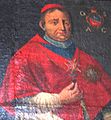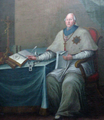Diocese of Livonia
The diocese of Livonia comprised areas in what is now Latvia and in the south of what is now Estonia and existed with changing dimensions and under changing names from 1582 to 1798.
history
prehistory
The Archdiocese of Riga , which in the Middle Ages comprised most of Livonia , was reformed in 1562 and 1563 . This was preceded in 1561 by the decision of the majority of the Livonian parliament to place themselves under the protection of the King of Poland and Grand Dukes of Lithuania during the Livonian War . In return, King Sigismund II August granted the Livonian estates in the Privilegium Sigismundi Augusti self-government, including the free practice of religion. As a result, the great majority of Livonian nobles (including their peasants) and the bourgeoisie switched - now openly - to the Lutheran denomination , to which most felt drawn and to which many nobles and citizens had already turned.
This medieval diocese / archbishopric of Riga, which perished in the middle of the 16th century as a result of the Reformation, is sometimes referred to in the sources and in older literature as the "diocese / archbishopric of Livonia".
The diocese of Livonia with its seat in Wenden
When Stephan Báthory became Polish king and thus also Duke of Livonia in 1576 , he tried to recatholize the Duchy of Livonia . In the course of this he created the Diocese of Livonia in 1582, also known as the "Diocese of Wenden" (Latin: Dioecesis Livoniae seu Vendensis ). The two names come from the fact that on the one hand it comprised the historical landscape of Livonia ( Latin Livonia ) and on the other hand the city of Wenden was designated as the bishopric. Because making Riga a bishopric again would not have been possible in view of the resistance of the local city council. On May 1, 1585, Pope Sixtus V approved the establishment of the diocese in retrospect.
The diocese of Inflanty / Livonia-Pilten with its seat in Dünaburg
After the Swedes under King Gustav II Adolf had conquered Livonia (including the city of Wenden) in 1621 and supported the Lutheran Church with all their might and oppressed the Catholic Church , the bishopric had to move to the city of Dünaburg , which was still under Polish-Lithuanian rule become. In 1622 the king enfeoffed his governor in Riga, the long-time Swedish chancellor Axel Oxenstierna , with the part of the diocese under his rule.
By the Treaty of Oliva in 1660, the diocese of Wenden was effectively abolished. Because according to Art. 4, § 2 of the contract, Catholics were only allowed to practice their faith “privately”, in their homes. Accordingly, the diocese was 24 years later, on September 19, 1684, by Pope Innocent XI. renamed in "Bishopric Inflanty" (the Polish name for Livonia / Livonia). The designation as the diocese of Wenden was omitted. Only a few months later, on January 15, 1685, another renaming took place in the "Diocese of Livonia-Pilten" ( Dioecesis Livoniae seu Vendensis et Piltinensis seu Curlandiae ), since the Diocese of Livonia with the Diocese of Pilten with seat in Pilten (also "Diocese of Courland “Called) was united.
Pope Pius VI dissolved after the third division of Poland in 1795 as part of the reorganization of the dioceses in the former state of Poland-Lithuania, the diocese on November 17, 1798. The last bishop, Johannes Nepomuk Kossakowski, was appointed Bishop of Vilnius in Lithuania on August 9, 1798 .
Bishops of Wenden, Livonia and Pilten
- Aleksander Mieliński (1583–1584)
- Andrzej Patrycy Nidecki (1585–1587)
- Otto von Schenking (1590–1637)
- Mikołaj Krosnowski (1641-1645)
- Jan Pac (1647)
- Aleksander Krzysztof Chodkiewicz (1651–1676)
- Mikołaj Popławski (1685-1710)
- Theodor Wolff von Lüdinghausen (1710) ( coadjutor 1701–1710)
- Krzysztof Antoni Szembek (1711-1716)
- Piotr Tarło (1717-1720)
- Stanisław Józef Hozjusz (1720–1722)
- Augustin Wessel (1724–1733)
- Konstanty Moszyński (1733–1738)
- Wacław Hieronim Sierakowski (1738–1739) (Coadjutor 1737–1738)
- Józef Dominik Puzyna (1740–1752)
- Antoni Kazimierz Ostrowski (1753–1763)
- Jan Stefan Giedroyć (1765–1778)
- Antoni Maciej Sierakowski (1778–1781)
- Joseph Kasimir Kossakowski (1781–1794)
- Jan Nepomucen Kossakowski (1794–1798) (coadjutor 1793–1794)
literature
- Jānis Broks: Katolicisms Latvijā 800 Gados: 1186–1986. Vēsturisks Atskats . Rīgas metropolijas kūrija, Riga 2002, ISBN 9984-619-40-0 (Latvian, translation of the title of the book: 800 years of Catholicism in Latvia, 1186–1986, historical review ).
- Grzegorz Fąs: Inflancka diecezja . In: Encyklopedia katolicka , Vol. 7, Lublin 1997, pp. 191-195 (Polish, translation of the title of the article: Diocese of Livonia ).
Web links
- Diocese of Inflanty (Livonia) -Pilten (English, incorrect)
Footnotes
- ↑ Reinhard Wittram : Baltic history. The Baltic countries of Livonia, Estonia, Courland 1180–1918 . Oldenbourg, Munich 1954, p. 81.
- ^ Arveds Schwabe: Histoire du peuple letton . Bureau d'Information de la Légation de Lettonie à Londres, Stockholm 1953, p. 120.
- ↑ Aloys Pichler : History of the ecclesiastical separation between the Orient and Occident from the first beginnings to the most recent present , Vol. 2: The Russian, Hellenic and the other oriental churches with a dogmatic part . Rieger, Munich 1865, p. 125.
- ^ Johann Christian Lünig : Das Teutsche Reichs-Archiv , Vol. 5: Des Teutsche Reichs-Archivs Pars Specialis . Leipzig 1713, p. 180.
- ↑ Jānis Broks: Katolicisms Latvijā 800 Gados: 1186-1986. Vēsturisks Atskats . Rīgas metropolijas kūrija, Riga 2002, p. 138.
- ↑ Bogusław Dybas: pin Pilten or circle Pilten? A contribution to the denominational politics of Poland-Lithuania in Livonia in the 17th century . In: Joachim Bahlcke (ed.): Confessional plurality as a challenge. Coexistence and Conflict in the Late Middle Ages and Early Modern Times . Leipziger Universitätsverlag, Leipzig 2006, ISBN 3-86583-081-1 , pp. 507-520, here p. 516.
- ↑ Josef Hergenröther : Handbuch der Allgemeine Kirchengeschichte , Vol. 3: The Church after the collapse of religious unity in the West and the spread of Christianity in the non-European parts of the world , Part 2: From the middle of the 17th century to the modern age . Herder, Freiburg im Breisgau 1909, p. 852.
- ↑ Jānis Broks: Katolicisms Latvijā 800 Gados: from 1186 to 1986. Vēsturisks Atskats . Rīgas metropolijas kūrija, Riga 2002, p. 146.
- ↑ Sigurds Rusmanis, Ivars Vīks: Kurzeme . Izdevniecība Latvijas Enciklopēdija, Riga 1993, ISBN 5-89960-030-6 , p. 191.






